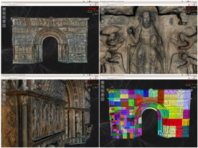20th International Conference on 3D Web Technology (Web3D 2015) Paper
 Federico Ponchio, Matteo Dellepiane – Visual Computing Lab CNR ISTI Pisa – “Fast decompression for web-based view-dependent 3D rendering.” Real time geometry processing has progressively reached a performance level that makes a number of signal-inspired primitives practical for on-line applications scenarios. This often comes through the joint design of operators, data structure and even dedicated hardware. Among the major classes of geometric operators, filtering and super-sampling (via tessellation) have been successfully expressed under high-performance constraints. The subsampling operator i.e., adaptive simplification, remains however a challenging case for non-trivial input models. In this paper, we build a fast geometry simplification algorithm over a new concept: Morton Integrals. By summing up quadric error metric matrices along Morton-ordered surface samples, we can extract concurrently the nodes of an adaptive cut in the so-defined implicit hierarchy, and optimize all simplified vertices in parallel.
Federico Ponchio, Matteo Dellepiane – Visual Computing Lab CNR ISTI Pisa – “Fast decompression for web-based view-dependent 3D rendering.” Real time geometry processing has progressively reached a performance level that makes a number of signal-inspired primitives practical for on-line applications scenarios. This often comes through the joint design of operators, data structure and even dedicated hardware. Among the major classes of geometric operators, filtering and super-sampling (via tessellation) have been successfully expressed under high-performance constraints. The subsampling operator i.e., adaptive simplification, remains however a challenging case for non-trivial input models. In this paper, we build a fast geometry simplification algorithm over a new concept: Morton Integrals. By summing up quadric error metric matrices along Morton-ordered surface samples, we can extract concurrently the nodes of an adaptive cut in the so-defined implicit hierarchy, and optimize all simplified vertices in parallel.
This approach is inspired by integral images and exploits recent advances in high performance spatial hierarchy construction and traversal. As a result, our GPU implementation can downsample a mesh made of sev eral millions of polygons at interactive rates, while providing better quality than uniform simplification and preserving important salient eatures. We present results for surface meshes, polygon soups and point clouds, and discuss variations of our approach to account for per-sample attributes and alternatives error metrics. Efficient transmission of 3D data to Web clients and mobile applications remains a challenge due to limited bandwidth. Most of the research focus in the context of mesh compression has been on improving compression ratio. However, in this context the use of Javascript on the Web and low power CPUS in mobile applications led to critical computational costs. Progressive decoding improves the user experience by providing a simplified version of the model that refines with time, and it’s able to mask latency. Current approaches do so at very poor compression rates or at additional computational cost. The need for better performing algorithms is especially evident with this class of methods where Limper [Limper et al. 2013b] demonstrated how decoding time becomes a limiting factor even at moderately low bandwidths. In this paper we present a novel multi-resolution WebGL based rendering algorithm which combines progressive loading, view-dependent resolution and mesh compression, providing high frame rates and a decoding speed of million of triangles per second in Javascript. This method is parallelizable, robust to non-manifold meshes, and scalable to very large models. (PDF)
